Fuchi-kashira made of shakudō carved and inlaid with gold and red copper with the design of a bat and a fruit (persimmon?). Nanako surface.
Fuchi: 37 x 19 x 7 mm. Kashira: 34 x 16 x 5 mm. Main material: shakudō. Other metals: gold and copper. Surface treatment: nanako-ji.-

-
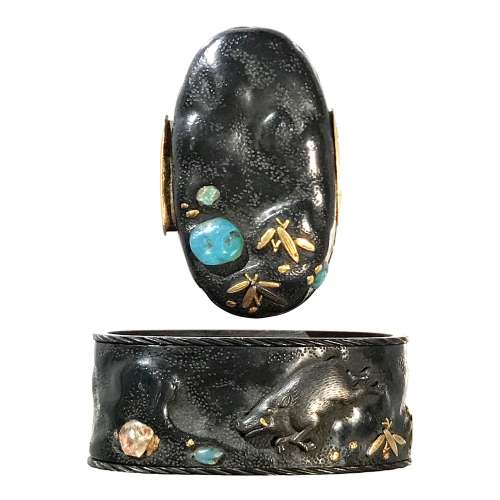 Signature: Unsigned
Signature: UnsignedFuchi-kashira with rock and boar (iwa ni inoshishi zu) motif. Inlay of precious stones or colour glass. Shakudō, gold, gemstones. Technique: Sukibori zogan kiniroe.
Fuchi: 36 x 21 x 14 mm; Weight: 22 g; Kashira: 32 x 17 x 5 mm; Weight: 8 g; Material : Shakudō; Gold; Gemstones (Chalcedony and Rose Quartz). Possibly, Owari school. -
 Fuchi: 38 x 22 x 12 mm. Kashira: 32 x 17 x 11 mm Main material: shakudo; surface treatment: nanako-ji; other metals: gold, shibuichi and copper; decorative technique: iroe takazogan. Signed: Nyudo Jounishi 人道 乗西 (possibly)
Fuchi: 38 x 22 x 12 mm. Kashira: 32 x 17 x 11 mm Main material: shakudo; surface treatment: nanako-ji; other metals: gold, shibuichi and copper; decorative technique: iroe takazogan. Signed: Nyudo Jounishi 人道 乗西 (possibly) -
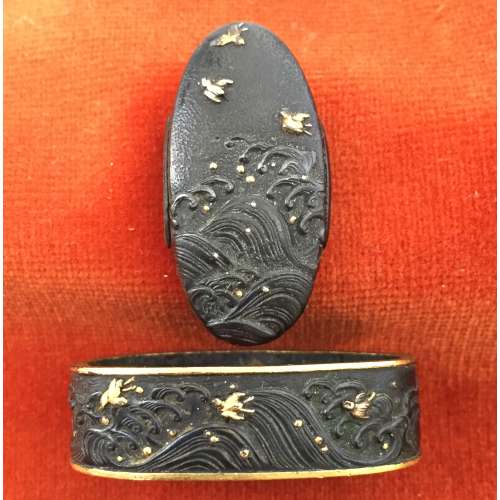 Fuchi: 37 x 21 x 11 mm; Weight: 13 g Kashira: 34 x 16 x 6 mm ; Weight: 10 g Material : Shakudo; Gold. Signature: Unsigned Technique: Sunameji Sukibori Zogan Decoration: Nami Chidori zu (wave & plover)
Fuchi: 37 x 21 x 11 mm; Weight: 13 g Kashira: 34 x 16 x 6 mm ; Weight: 10 g Material : Shakudo; Gold. Signature: Unsigned Technique: Sunameji Sukibori Zogan Decoration: Nami Chidori zu (wave & plover) -
 Fuchi: 38 x 22 x 14 mm. Kashira: 33 x 18 x 9 mm Techniques: Usu-shishiai-bori (薄肉合彫) – low-relief, zogan.
Fuchi: 38 x 22 x 14 mm. Kashira: 33 x 18 x 9 mm Techniques: Usu-shishiai-bori (薄肉合彫) – low-relief, zogan. -
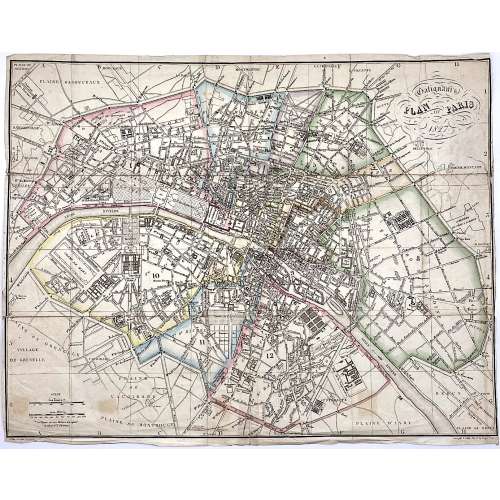 Upper right: Galignani's | PLAN OF PARIS | 1827 || in oval frame: Sauve sculpt. Bottom, under the frame: le Plan écrit par Lallemand. […] Gravé par E. Collin. Rue de la Harpe № 45. Dimensions: 36.5 x 46.5 cm. Armand Joseph Lallemand (French, c. 1810 - 1871) – cartographer. Charles-Étienne Collin (French, 1770 – 1840) – engraver. Étienne Collin II (French,1790 – 1852) – engraver. John Anthony Galignani (Italian, 1796 – 1873) – publisher. William Galignani (Italian, 1798 – 1882) – publisher.
Upper right: Galignani's | PLAN OF PARIS | 1827 || in oval frame: Sauve sculpt. Bottom, under the frame: le Plan écrit par Lallemand. […] Gravé par E. Collin. Rue de la Harpe № 45. Dimensions: 36.5 x 46.5 cm. Armand Joseph Lallemand (French, c. 1810 - 1871) – cartographer. Charles-Étienne Collin (French, 1770 – 1840) – engraver. Étienne Collin II (French,1790 – 1852) – engraver. John Anthony Galignani (Italian, 1796 – 1873) – publisher. William Galignani (Italian, 1798 – 1882) – publisher. -
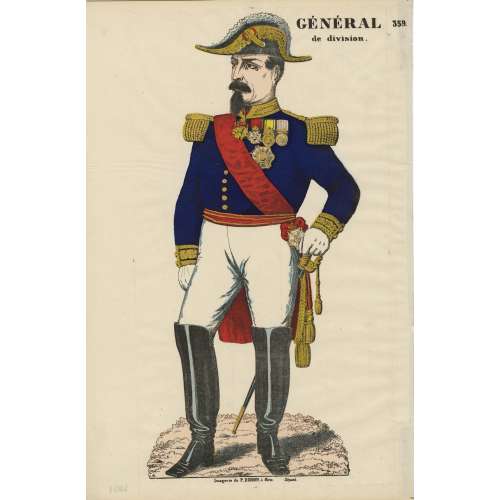 Hand-coloured woodcut on wove paper, 430 x 285 mm; black ink stamp “5051” to reverse. Top right: "GÉNÉRAL | de division." — "359." Bottom: "Imagerie de DIDION, à Metz. Déposé." Paulin Didion (French, 1831 – 1879) – publisher/printer.
Hand-coloured woodcut on wove paper, 430 x 285 mm; black ink stamp “5051” to reverse. Top right: "GÉNÉRAL | de division." — "359." Bottom: "Imagerie de DIDION, à Metz. Déposé." Paulin Didion (French, 1831 – 1879) – publisher/printer. -
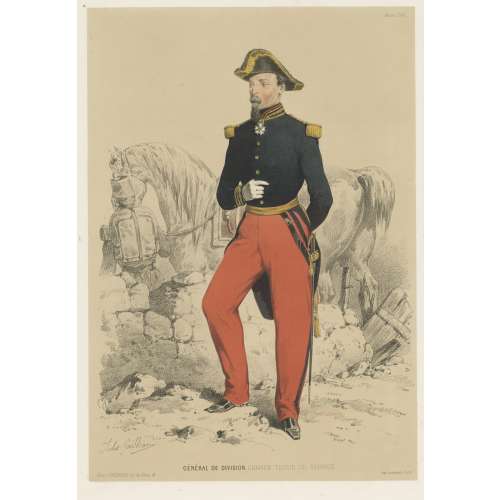 Chromolithography on thick wove paper, 473 x 315 mm sheet, 372 x 260 mm image, black ink stamp “5050” to reverse. Signed on stone "Jules Gaildrau"; below centre: "GÉNERAL DE DIVISION, GRANDE TENUE DE SERVICE"; Bottom left: "Paris, J. Gaildrau, rue de Seine, 16"; right: "Imp. Lemercier, Paris." Joseph Lemercier (French, 1803 – 1887) – printer. Jules Gaildrau (French, 1816 – 1898) – artist.
Chromolithography on thick wove paper, 473 x 315 mm sheet, 372 x 260 mm image, black ink stamp “5050” to reverse. Signed on stone "Jules Gaildrau"; below centre: "GÉNERAL DE DIVISION, GRANDE TENUE DE SERVICE"; Bottom left: "Paris, J. Gaildrau, rue de Seine, 16"; right: "Imp. Lemercier, Paris." Joseph Lemercier (French, 1803 – 1887) – printer. Jules Gaildrau (French, 1816 – 1898) – artist. -
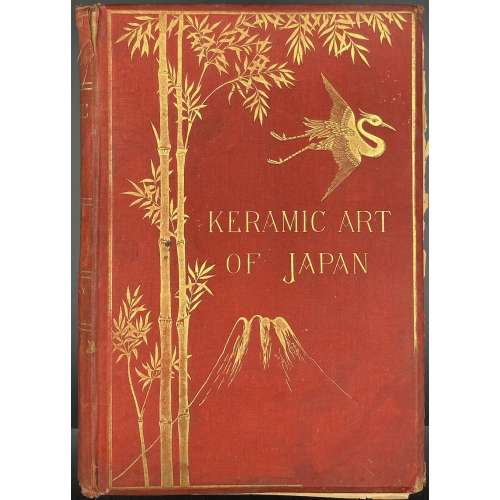 Title-page (in red and black): Keramic art of Japan, | BY | GEORGE A. AUDSLEY | AND | JAMES L. BOWES. | LONDON: HENRY SOTHERAN & CO., | 36 PICADILLY; 136, STRAND; 77 & 78, QUEEN STREET, CITY. | MANCHESTER: 49, CROSS STREET. | MDCCCLXXXI. || Description: 28.5 x 19.5 cm, publisher’s red cloth, bevelled boards, gilt lettering and tooling on front cover and spine, AEG, disbound. 304 p., 10 pl., 32 chromo-lithographed plates. This is the 2nd edition of the 1875 folio edition by the same publisher.. Contents: Introductory essay on Japanese art: p. 1-107; Keramic art of Japan: p. 108-260; Marks and monograms: p. 261-287, Index: p. 288-304. Contributors: George Ashdown Audsley (American, 1838 – 1925) – author. James Lord Bowes (British, 1834 – 1899) – author.
Title-page (in red and black): Keramic art of Japan, | BY | GEORGE A. AUDSLEY | AND | JAMES L. BOWES. | LONDON: HENRY SOTHERAN & CO., | 36 PICADILLY; 136, STRAND; 77 & 78, QUEEN STREET, CITY. | MANCHESTER: 49, CROSS STREET. | MDCCCLXXXI. || Description: 28.5 x 19.5 cm, publisher’s red cloth, bevelled boards, gilt lettering and tooling on front cover and spine, AEG, disbound. 304 p., 10 pl., 32 chromo-lithographed plates. This is the 2nd edition of the 1875 folio edition by the same publisher.. Contents: Introductory essay on Japanese art: p. 1-107; Keramic art of Japan: p. 108-260; Marks and monograms: p. 261-287, Index: p. 288-304. Contributors: George Ashdown Audsley (American, 1838 – 1925) – author. James Lord Bowes (British, 1834 – 1899) – author. -
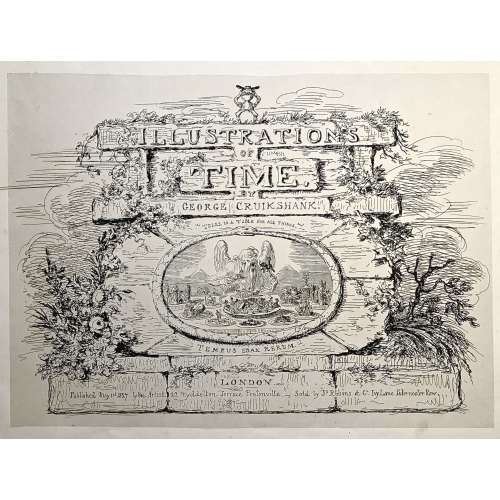
Engraved title page: ILLUSTRATION | OF | TIME. | GEORGE CRUIKSHANK. | "THERE IS A TIME FOR ALL THINGS". | TEMPUS EDAX RERUM. | LONDON | Published May 1st 1827 by the Artist - 22 Myddelton Terrace Pentonville. - Sold by Js. Robins & Co. Ivy Lane Paternoster Row.
Oblong folio, 33.5 x 44 cm. Engraved vignette title page and six not-coloured engraved plates with multiple images showing thirty-five humorous scenes.
First edition, first issue. Uncoloured. Pristine condition.
Half-leather bound in marbled cardboard and red morocco and gild lettering and arabesque. Frontispiece and 6 plates with protective tissues.
Content:1. Time-Called & Time-Come (five sketches)
2. Behind Time (seven sketches)
3. Time Thrown Away (six sketches)
4. Hard Times [&] Term Time (five sketches)
5. Time Badly Employed (five sketches)
6. Christmas Time (seven sketches)
British Museum № 1978,U.3026.1. BM description: "Frontispiece, the title on a background of symmetrical but dilapidated and grass-grown masonry. On the summit stands a little laughing gnome, with a wide hat and a body formed of an hour-glass; Inset is an oval bordered by a serpent with its tail in its mouth (emblem of eternity), in which is an aged and all-devouring Time (bald except for a forelock), seated behind a table whose surface is the base of the design. He puts to his mouth a fork on which is speared an elephant with a castle on its back containing tiny figures with spears. In his r. hand is a spoon containing a country church. His table is covered with dishes, and at his r. hand is a sickle. The central and biggest dish is heaped with a jumble of tiny objects: crown, table, chair, wheelbarrow, picture; round the room sit little figures: a soldier, parson, lady and child, &c. The ten other dishes contain: an antique glass coach with horses and footmen; an overladen camel beside a palm-tree; ruins of a castle; a farmhouse; a shepherd and sheep; a dismantled cannon and balls, cattle, a man-of-war in full sail; a ruinous Gothic cathedral; a clump of trees (the last two are dominated by a large decanter). Below Time are two (Egyptian) pyramids. Above: 'There Is A Time For All Things'; below: 'Tempus Edax Rerum'. 1 May 1827. Etching."Bibliography:- Reid, G W, A descriptive catalogue of the works of George Cruikshank, London, 1871.
- Stephens, Frederic George; George, Mary Dorothy, Catalogue of Political and Personal Satires in the Department of Prints and Drawings in the British Museum, 11 vols, London, BMP, 1870.
- Cohn, A M, George Cruikshank, catalogue raisonné, London, 1924.
-
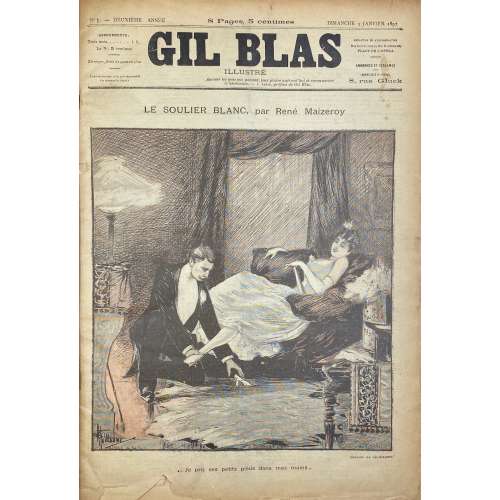 52 issues of French weekly Gil Blas illustré, 1892: №№ 1-52; published in Paris, 39 x 29 cm, bound in red half cloth over marbled boards, with gilt fillets and lettering to spine, marbled endpapers, profusely illustrated by Théophile Steinlen (Swiss-French, 1859 – 1923) and Albert Guillaume (French, 1873 – 1942).
52 issues of French weekly Gil Blas illustré, 1892: №№ 1-52; published in Paris, 39 x 29 cm, bound in red half cloth over marbled boards, with gilt fillets and lettering to spine, marbled endpapers, profusely illustrated by Théophile Steinlen (Swiss-French, 1859 – 1923) and Albert Guillaume (French, 1873 – 1942). -
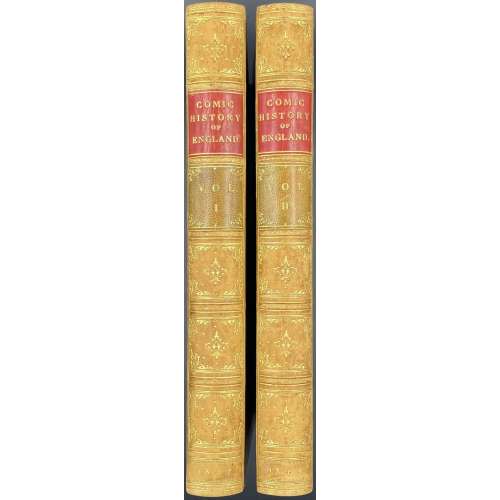 Vol. 1: Title page (red and black): THE | COMIC HISTORY OF ENGLAND • | BY GILBERT ABBOTT A'BECKETT. | {vignette with one line caption} | WITH TEN COLOURED ETCHINGS AND ONE HUNDRED AND TWENTY | WOODCUTS, | BY JOHN LEECH. | VOL. I. | PUBLISHED AT THE PUNCH OFFICE, 85, FLEET STREET. | MDCCCXLVII. || Pagination: [iii-iv] – t.p. / imprint., [v]-vi – preface, [vii]-viii – contents, [ix]-xii – list of ills. [1] 2-320, lacking half-title otherwise as called for by Tooley (1935) p. 161. Collation: 8vo; π3 b2 B-X8 plus 10 plates, incl. frontispiece, of hand-coloured steel engravings and 120 in-text woodcuts by John Leech. Vol. 2: Title page: similar but “VOL. II.” And “MDCCCXLVIII”; typeface “with ten coloured…” is different (sans serif). Pagination: [iii-iv] – t.p. / imprint., [v]-vi – advert., [vii]-viii – contents, [ix]-xii – list of ills. [1] 2-304, lacking half-title otherwise as called for by Tooley (1935) p. 161. Collation: 8vo; π3 b2 B-U8 X2 plus 10 plates, incl. frontispiece, of hand-coloured steel engravings and 120 in-text woodcuts by John Leech. Binding: two volumes 22 x 14.5 cm each uniformly bound in full tan calf with gilt double-fillet border, spine gilt in compartments with red and green morocco labels lettered in gilt, blind-stamped dentelle inside, blue marbled endpapers, all edges marbled, additional flyleafs at the front and end. Catalogue raisonné: Hardie p. 210-11; Abbey, Life № 434, p. 362; Tooley (1935) p. 161 Contributors: Gilbert Abbott à Beckett (British, 1811 – 1856) – author. John Leech (British, 1817 – 1864) – artist. Bradbury & Evans (Whitefriars); William Bradbury (British, 1799 – 1869); Frederick Mullett Evans (British, 1804 – 1870) – printer. Punch – publisher.
Vol. 1: Title page (red and black): THE | COMIC HISTORY OF ENGLAND • | BY GILBERT ABBOTT A'BECKETT. | {vignette with one line caption} | WITH TEN COLOURED ETCHINGS AND ONE HUNDRED AND TWENTY | WOODCUTS, | BY JOHN LEECH. | VOL. I. | PUBLISHED AT THE PUNCH OFFICE, 85, FLEET STREET. | MDCCCXLVII. || Pagination: [iii-iv] – t.p. / imprint., [v]-vi – preface, [vii]-viii – contents, [ix]-xii – list of ills. [1] 2-320, lacking half-title otherwise as called for by Tooley (1935) p. 161. Collation: 8vo; π3 b2 B-X8 plus 10 plates, incl. frontispiece, of hand-coloured steel engravings and 120 in-text woodcuts by John Leech. Vol. 2: Title page: similar but “VOL. II.” And “MDCCCXLVIII”; typeface “with ten coloured…” is different (sans serif). Pagination: [iii-iv] – t.p. / imprint., [v]-vi – advert., [vii]-viii – contents, [ix]-xii – list of ills. [1] 2-304, lacking half-title otherwise as called for by Tooley (1935) p. 161. Collation: 8vo; π3 b2 B-U8 X2 plus 10 plates, incl. frontispiece, of hand-coloured steel engravings and 120 in-text woodcuts by John Leech. Binding: two volumes 22 x 14.5 cm each uniformly bound in full tan calf with gilt double-fillet border, spine gilt in compartments with red and green morocco labels lettered in gilt, blind-stamped dentelle inside, blue marbled endpapers, all edges marbled, additional flyleafs at the front and end. Catalogue raisonné: Hardie p. 210-11; Abbey, Life № 434, p. 362; Tooley (1935) p. 161 Contributors: Gilbert Abbott à Beckett (British, 1811 – 1856) – author. John Leech (British, 1817 – 1864) – artist. Bradbury & Evans (Whitefriars); William Bradbury (British, 1799 – 1869); Frederick Mullett Evans (British, 1804 – 1870) – printer. Punch – publisher. -
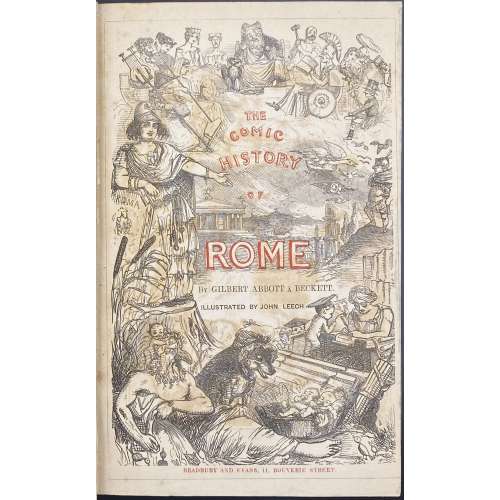 Woodcut pictorial title page (red and black): THE | COMIC | HISTORY | OF | ROME | By GILBERT ABBOTT À BECKETT. | ILLUSTRATED BY JOHN LEECH. | BRADBURY AND EVANS, 11, BOUVERIE STREET. || Pagination: [iii-iv] – t.p. / imprint., [v]-vi – preface, [vii]-viii – contents, [ix]-xii – list of ills., [1] 2-308, lacking half-title (i-ii) otherwise as called for by Tooley (1935) p. 162. Collation: π1 b4 B-U8 X2 plus 10 plates, incl. frontispiece, of hand-coloured steel engravings and 98 in-text woodcuts by John Leech. Imprint: “LONDON: | BRADBURY AND EVANS, PRINTERS, WHITEFRIARS.”; same in the colophon on p. 308, in one line. Binding: 22 x 14.5 cm, full tan calf with gilt double-fillet border, spine gilt in compartments with red morocco label lettered in gilt, blind-stamped dentelle inside, marbled endpapers, additional flyleaf at the end (binding similar to 2-volume “The Comic History of England” LIB-2847.2021, making three volumes in total). Edition: 1st thus (in book form), without “and Co.” in the imprint on t.p. verso. Catalogue raisonné: Tooley (1935) p. 162. Catalogue raisonné: Hardie p. 210; Abbey, Life № 435, p. 365-6; Tooley (1935) p. 162. Contributors: Gilbert Abbott à Beckett (British, 1811 – 1856) – author. John Leech (British, 1817 – 1864) – artist. Bradbury & Evans (Whitefriars); William Bradbury (British, 1799 – 1869); Frederick Mullett Evans (British, 1804 – 1870) – printer.
Woodcut pictorial title page (red and black): THE | COMIC | HISTORY | OF | ROME | By GILBERT ABBOTT À BECKETT. | ILLUSTRATED BY JOHN LEECH. | BRADBURY AND EVANS, 11, BOUVERIE STREET. || Pagination: [iii-iv] – t.p. / imprint., [v]-vi – preface, [vii]-viii – contents, [ix]-xii – list of ills., [1] 2-308, lacking half-title (i-ii) otherwise as called for by Tooley (1935) p. 162. Collation: π1 b4 B-U8 X2 plus 10 plates, incl. frontispiece, of hand-coloured steel engravings and 98 in-text woodcuts by John Leech. Imprint: “LONDON: | BRADBURY AND EVANS, PRINTERS, WHITEFRIARS.”; same in the colophon on p. 308, in one line. Binding: 22 x 14.5 cm, full tan calf with gilt double-fillet border, spine gilt in compartments with red morocco label lettered in gilt, blind-stamped dentelle inside, marbled endpapers, additional flyleaf at the end (binding similar to 2-volume “The Comic History of England” LIB-2847.2021, making three volumes in total). Edition: 1st thus (in book form), without “and Co.” in the imprint on t.p. verso. Catalogue raisonné: Tooley (1935) p. 162. Catalogue raisonné: Hardie p. 210; Abbey, Life № 435, p. 365-6; Tooley (1935) p. 162. Contributors: Gilbert Abbott à Beckett (British, 1811 – 1856) – author. John Leech (British, 1817 – 1864) – artist. Bradbury & Evans (Whitefriars); William Bradbury (British, 1799 – 1869); Frederick Mullett Evans (British, 1804 – 1870) – printer. -
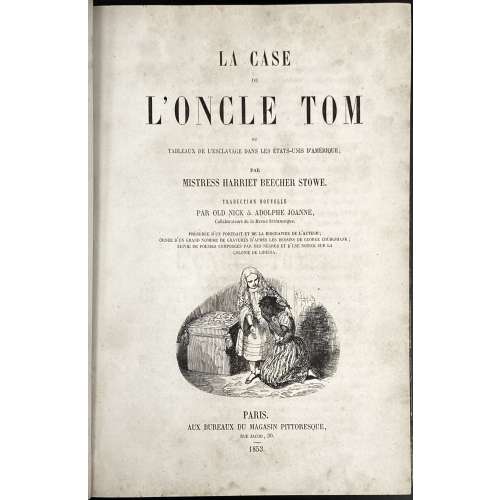 1st French edition (Paris, 1853) of Harriet Beecher Stowe's book Uncle Tom's Cabin; or, Life Among the Lowly, with 27 illustrations on wood by George Cruikshank (British, 1792 – 1878), translated into French by Paul-Émile Daurand-Forgues [pseudonym Old Nick] (French, 1813 – 1883) and Adolphe Joanne (French, 1813 – 1881). Title: LA CASE | DE | L'ONCLE TOM | OU | TABLE AUX DE L'ESCLAVAGE DANS LES ÉTATS-UNIS D'AMÉRIQUE ; | PAR MISTRESS HARRIET BEECHER STOWE. | TRADUCTION NOUVELLE | PAR OLD NICK & ADOLPHE JOANNE, | Collaboarteurs de la Revue britannique, | PRÉCÉDÉE D'UN PORTRAIT ET DE LA BIOGRAPHIE DE L'AUTEUR; | ORNÉE D'IU GRAND NOMBRE DE GRAVURES D'APRES LES DESSINS DE GEORGE CRUIKSHANK ; | SUIVIE DE POÉSIES COMPOSÉES PAR DES NÈGRES ET D'UNE NOTICE SUR LA | COLONIE DE LIBERIA. | [vignette] | PARIS. | AUX BUREAUX DU MAGASIN PITTORESQUE, | RUE JACOB, 30. | 1853. Pagination: ffl blank; [i-ii]: h.t. with stamped letters D. W. in the upper centre / imprim. to verso; [iii-iv] t.p. / blank; [v-vi] blank / frontispiece: portrait of Harriet Beecher Stowe, half-length to left, with hair in ringlets, and a shawl over shoulders, landscape behind, Henry Linton (British, 1815 – 1899) after Henry Anelay (British,1817 – 1883), wood-engraving with letterpress; [vij] Viij-xij; [1] 2-563 [564]; bfl blank; illustrations: 27 woodcuts by George Cruikshank. Collation: 8vo, π7 (1)–(35)8 363 Binding: Quarter brown calf, spine with raised bands, gilt-ruled compartments, title lettering, "D. W." in the bottom, marbled boards and endpapers. Dimensions: 24.1 x 16.4 cm. Catalogue raisonné: Albert M. Cohen (1924), №777, p. 221. "An edition was published in French with the woodcuts direct from the blocks, not, as in the English, merely from the stereotypes. The illustrations are far more impressive than those of Cassell's edition".
1st French edition (Paris, 1853) of Harriet Beecher Stowe's book Uncle Tom's Cabin; or, Life Among the Lowly, with 27 illustrations on wood by George Cruikshank (British, 1792 – 1878), translated into French by Paul-Émile Daurand-Forgues [pseudonym Old Nick] (French, 1813 – 1883) and Adolphe Joanne (French, 1813 – 1881). Title: LA CASE | DE | L'ONCLE TOM | OU | TABLE AUX DE L'ESCLAVAGE DANS LES ÉTATS-UNIS D'AMÉRIQUE ; | PAR MISTRESS HARRIET BEECHER STOWE. | TRADUCTION NOUVELLE | PAR OLD NICK & ADOLPHE JOANNE, | Collaboarteurs de la Revue britannique, | PRÉCÉDÉE D'UN PORTRAIT ET DE LA BIOGRAPHIE DE L'AUTEUR; | ORNÉE D'IU GRAND NOMBRE DE GRAVURES D'APRES LES DESSINS DE GEORGE CRUIKSHANK ; | SUIVIE DE POÉSIES COMPOSÉES PAR DES NÈGRES ET D'UNE NOTICE SUR LA | COLONIE DE LIBERIA. | [vignette] | PARIS. | AUX BUREAUX DU MAGASIN PITTORESQUE, | RUE JACOB, 30. | 1853. Pagination: ffl blank; [i-ii]: h.t. with stamped letters D. W. in the upper centre / imprim. to verso; [iii-iv] t.p. / blank; [v-vi] blank / frontispiece: portrait of Harriet Beecher Stowe, half-length to left, with hair in ringlets, and a shawl over shoulders, landscape behind, Henry Linton (British, 1815 – 1899) after Henry Anelay (British,1817 – 1883), wood-engraving with letterpress; [vij] Viij-xij; [1] 2-563 [564]; bfl blank; illustrations: 27 woodcuts by George Cruikshank. Collation: 8vo, π7 (1)–(35)8 363 Binding: Quarter brown calf, spine with raised bands, gilt-ruled compartments, title lettering, "D. W." in the bottom, marbled boards and endpapers. Dimensions: 24.1 x 16.4 cm. Catalogue raisonné: Albert M. Cohen (1924), №777, p. 221. "An edition was published in French with the woodcuts direct from the blocks, not, as in the English, merely from the stereotypes. The illustrations are far more impressive than those of Cassell's edition". -
 This print was sold to me with the following description: "Ikkansai EISHO (Fl. early 19th c.). A portrait of the wrestler Kuroyanagi Matsujiro, ring name Kumagatake Inosuke. Eisho was a pupil of Eishi. Published c. 1820s by Uoya Eikichi. Signed Shunsai Eisho ga." As a result of our joint effort with my beloved sister, we have so far found the following: The artis is mentioned in The Hotei Encyclopedia of Japanese Woodblock Prints, 2005, Vol 2; p. 438 under the name of Harukawa Eichō. From this source we learned that the artist was active from about 1818 till 1844, and was a print designer in Kyoto. He was a student first of Harukawa Goshichi and later studied in Edo (Tokyo) with Keisai Eisen, when he assumed the art name 'Eichō'. Other names: Shunsai. The Japanese web page dedicated to Harukawa Eichō provides more details: The artist lived from the 4th year of Tenmei ( 1784 ) to the first year of Kaei ( 1848 ). He was a student of Harukawa Goshichi, Kikukawa Eizan as well as of Keisai Eisen. His popular name was Kamenosuke. He was from Kyoto. He took "gagō" (artistic names) of Eishō when he was a student of Harukawa Goshichi; later, when he became a student of Kikukawa Eizan and Keisai Eisen he took the name of Kikukawa Eichō. The artist was mostly known for his bijinga (beautiful women) prints as well as kanazōshi illustrations. Nothing is said anywhere about his sumo prints, though the reference to another Kyushu sumo wrestler portrait has been found. The sumo wrestler Kuroyanagi Matsujiro is also a somewhat obscure figure: information about his life and career is quite inconsistent. It may so happened that two different persons were combined together. Wikipedia page about Aoi Aso Jinja, a Shinto shrine in Hitoyoshi in Kumamoto prefecture, tells us the following:This information has some inconsistencies already. If our hero was born in 1807 and promoted to ōzeki at the age of 32, it should have been the year 1839, not 1847. I found Kumagatake Isuke at "Sumo Reference" website:
This print was sold to me with the following description: "Ikkansai EISHO (Fl. early 19th c.). A portrait of the wrestler Kuroyanagi Matsujiro, ring name Kumagatake Inosuke. Eisho was a pupil of Eishi. Published c. 1820s by Uoya Eikichi. Signed Shunsai Eisho ga." As a result of our joint effort with my beloved sister, we have so far found the following: The artis is mentioned in The Hotei Encyclopedia of Japanese Woodblock Prints, 2005, Vol 2; p. 438 under the name of Harukawa Eichō. From this source we learned that the artist was active from about 1818 till 1844, and was a print designer in Kyoto. He was a student first of Harukawa Goshichi and later studied in Edo (Tokyo) with Keisai Eisen, when he assumed the art name 'Eichō'. Other names: Shunsai. The Japanese web page dedicated to Harukawa Eichō provides more details: The artist lived from the 4th year of Tenmei ( 1784 ) to the first year of Kaei ( 1848 ). He was a student of Harukawa Goshichi, Kikukawa Eizan as well as of Keisai Eisen. His popular name was Kamenosuke. He was from Kyoto. He took "gagō" (artistic names) of Eishō when he was a student of Harukawa Goshichi; later, when he became a student of Kikukawa Eizan and Keisai Eisen he took the name of Kikukawa Eichō. The artist was mostly known for his bijinga (beautiful women) prints as well as kanazōshi illustrations. Nothing is said anywhere about his sumo prints, though the reference to another Kyushu sumo wrestler portrait has been found. The sumo wrestler Kuroyanagi Matsujiro is also a somewhat obscure figure: information about his life and career is quite inconsistent. It may so happened that two different persons were combined together. Wikipedia page about Aoi Aso Jinja, a Shinto shrine in Hitoyoshi in Kumamoto prefecture, tells us the following:This information has some inconsistencies already. If our hero was born in 1807 and promoted to ōzeki at the age of 32, it should have been the year 1839, not 1847. I found Kumagatake Isuke at "Sumo Reference" website:Kuroki Matsujiro (黒木松次郎) was born in the village of Itsuki in Kuma district, Kumamoto prefecture, island of Kyushu in Bunka era, 4th year (1807). Since from his childhood he was blessed by great physique and tough strength. He had affection for sumo. At the age of 18 he became a sumo student of Kumamoto Shimakawa Ikuhei and took the name of Toyama Hidekichi (遠山日出吉). At the age of 23 (1830), he entered sumo stables in Kyoto, mastered the art of taming of young horses, and his talents improved. At the age of 31 he went to Edo, and became a disciple of the ōzeki Oitekaze Kitaro of Hirado domain in Hizen province, also from Kyushu island. After that, he changed his name and became Kuroyanagi Matsujiro (黒柳松次郎 – as on the print). In 1847 (Bunka era, 4th year) he distinguished himself by advancing to the first grade, and at the age of 32 he was promoted to ozeki level, becoming sekitori. After changing his name to Kuma-ga-take Inosuke (熊ヶ嶽猪之介 / くまがたけいのすけ) he displayed further efforts, and became one of the strongmen that fermented sumo wrestling in Edo. In 1853 (Kaei era, 6th year) he retired and returned to his village, becoming an employee as a strongman of Sagara domain (相良藩), and worked hard as instructor of the sumo training hall to train successors until 1855 (Ansei era, 2nd year) when he passed away at the age of 48. Even today Kuma-ga-take's home exists in Itsukimura (his native village). Also, on those grounds a descendant of Kuma-ga-take runs minshuku (guest house) that bears the name of "The Kuroki Pension (lodging) ", and tourists come to visit from various parts of Japan. In 2015, tenth month, within the borders of Aoi Aso Shrine there was built a gravestone publicly honoring Kuma-ga-take Inosuke, sumo wrestler from Edo / of Edo period.
The real name is the same, the ring name Kuroyanagi Matsujiro is the same, however, the date of birth here is 1815. He fought from 1836 till 1853 - which is quite similar to "At the age of 31 he went to Edo, and became a disciple of the ōzeki Oitekaze Kitaro". Though, in 1836 he might be 29 years old. His bouts are listed from spring 1841 to spring 1848 under the name of Kuroyanagi and from winter 1848 till spring 1853 he listed under the name of Kumagatake Isuke [Inosuke].Highest Rank Maegashira 4 Real Name Kuroki Birth Date 1815 Shusshin Kumamoto-ken, Kuma-gun Death Date March 6, 1855 (40 years) Heya Oitekaze Shikona Kuroyanagi Matsujiro - Kumagatake Isuke Hatsu Dohyo 1836.02 (Sandanme) Intai 1853.02 On another important sumo history website, I found that Kuroyanagi first appeared at ring in the spring of 1823 (he might have been 16 years old then, which does not seem right). Then, in the winter tournament of 1848 Kuroyanagi took the name Kumagatake. At the spring tournament of 1853 Kumagatake (Kuroyanagi) retired. This is quite consistent so far.
Then, I found Oitekaze Kitaro, allegedly the teacher of Kuroyanagi.
Everything look good with an exception of ring names (shikona): Kuroyanagi Matsujiro (1823-1828) - Kuroyanagi Sumiemon (1829-30) - Oitekaze Kitaro (1831-1839). May it be that Sato Matsutaro fought under the name of Kuroyanagi Matsujiro until Kuroki Matsujiro took this name from his master? I don't have another explanation of the enigma. What we know is that we have a portrait of a sumo wrestler called Kuroyanagi Matsujiro from Kyushu, but we don't know whether this was the one from Kumamoto (Kumagatake Inosuke, 1807/1815-1855) or the other from Kanagawa (Oitekaze Kitaro, 1799-1865). Subsequently, we may declare that the artist is Shunsai Eishō, a.k.a.Harukawa Eichō from Eishi school (The Hotei Encyclodepdia, p. 524), we can date the print from 1818 to 1844, and only tell that the wrestler is Kuroyanagi Matsujiro from Kyushu (either Kumagatake Inosuke or Oitekaze Kitaro). The publisher of the print is Moriya Jihei (Marks №353, p. 243-5). That's it.Highest Rank Ozeki Real Name SATO Matsujiro (Matsutaro#) Birth Date 1799 Shusshin Kanagawa-ken, Tsukui-gun Death Date May 4, 1865 (66 years) Heya Oitekaze Shikona Kuroyanagi Matsujiro - Kuroyanagi Sumiemon - Oitekaze Kitaro Hatsu Dohyo 1817.10 (Jonokuchi) Intai 1839.03 -
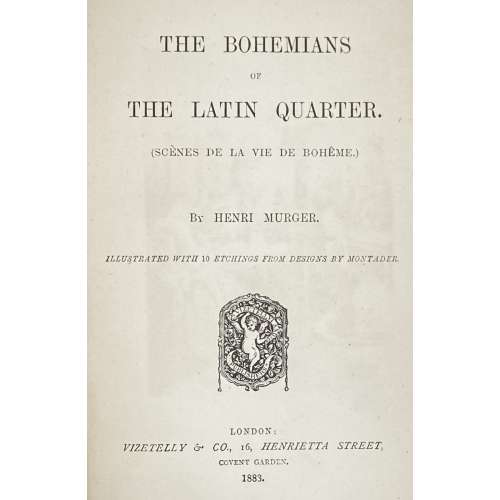 Title: THE BOHEMIANS | OF | THE LATIN QUARTER. | (SCÈNES DE LA VIE DE BOHÊME.) | By HENRI MURGER. | ILLUSTRATED WITH 10 ETCHINGS FROM DESIGNS BY MONTADER. |{publisher’s device}| LONDON: | VIZETELLY & CO., 16, HENRIETTA STREET, | COVENT GARDEN. | 1888. || Pagination: [i-v] vi-xxxiv, [1] 2-317 [318 blank]; collation: 8vo, π1 (h.t.), [a]-b8, B-U8 X7 + 10 etchings by Charles Courtry after Alfred Montader (incl. frontispiece and portrait of Henri Murger). Binding: 23 x 14.5 cm, olive cloth, black lettering to cover and gilt lettering to spine. Contributors: Murger, Henri [Henry] (French, 1822 – 1861) – original text (French). Montader, Pierre Marie Alfred (French, fl. c. 1881 – 1925) – artist. Courtry, Charles Jean Louis (French, 1846 – 1897) – engraver. Vizetelly, Henry Richard (British, 1820 – 1894) – publisher.
Title: THE BOHEMIANS | OF | THE LATIN QUARTER. | (SCÈNES DE LA VIE DE BOHÊME.) | By HENRI MURGER. | ILLUSTRATED WITH 10 ETCHINGS FROM DESIGNS BY MONTADER. |{publisher’s device}| LONDON: | VIZETELLY & CO., 16, HENRIETTA STREET, | COVENT GARDEN. | 1888. || Pagination: [i-v] vi-xxxiv, [1] 2-317 [318 blank]; collation: 8vo, π1 (h.t.), [a]-b8, B-U8 X7 + 10 etchings by Charles Courtry after Alfred Montader (incl. frontispiece and portrait of Henri Murger). Binding: 23 x 14.5 cm, olive cloth, black lettering to cover and gilt lettering to spine. Contributors: Murger, Henri [Henry] (French, 1822 – 1861) – original text (French). Montader, Pierre Marie Alfred (French, fl. c. 1881 – 1925) – artist. Courtry, Charles Jean Louis (French, 1846 – 1897) – engraver. Vizetelly, Henry Richard (British, 1820 – 1894) – publisher. -
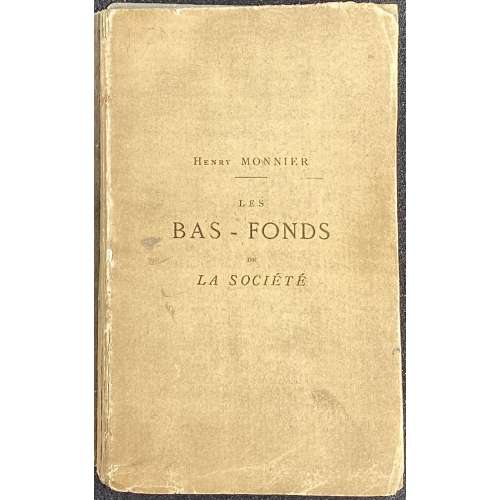 Small softcover volume, ‘édition minuscule’ in-32, 13 x 8 cm, publisher’s wrappers, pp.: [1-6] (h.t., t.p., advert.), [7] 8-160 [2 table/blank], included in pagination 8 pasted etchings on India paper after Félicien Rops and one blank leaf next to plate 1; laid paper with watermarks, some pages uncut. Title-page: DOCUMENTS | POUR SERVIR A L’HISTOIRE DE NOS MŒURS | – | LES | BAS-FONDS | DE LA SOCIÉTÉ | PAR | HENRY MONNIER | AVEC | 8 dessins à la plume | de F. R. | {fleuron} | ÉDITION MINUSCULE | tirée | à 64 exemplaires. || Pencil handwriting on top: 8 gravures de Felicien Rops | 250 –, in the bottom: [1879]. Print run: 64 copies; clandestine edition. Catalogue raisonné: Vicaire V, 1019; Bory p. 100 (though here is the frontispiece for Les Bas-fonds de la société par Joseph Prudhomme [Henry Monnier], 1864, with all the sheets together; Dutel I, A-134. Ref: (1) Poulet-Malassis & ses amis № 90 [LIB-3118.2022] ; (2) Félicien Rops: L'oeuvre graphique complète. / Ouvrage établi et présenté par Jean-François Bory. Avec un texte contemporain de l'artiste par J. K. Huysmans. — Arthur Hubschmidt, 1977. [LIB-2241.2019] Contributors: Henry Monnier (French, 1799 – 1877) – author. Félicien Rops (Belgian, 1833 – 1898) – artist. Henry Kistemaeckers (Belgian, 1851 – 1934) – publisher. Auguste Poulet-Malassis (French, 1825 – 1878)
Small softcover volume, ‘édition minuscule’ in-32, 13 x 8 cm, publisher’s wrappers, pp.: [1-6] (h.t., t.p., advert.), [7] 8-160 [2 table/blank], included in pagination 8 pasted etchings on India paper after Félicien Rops and one blank leaf next to plate 1; laid paper with watermarks, some pages uncut. Title-page: DOCUMENTS | POUR SERVIR A L’HISTOIRE DE NOS MŒURS | – | LES | BAS-FONDS | DE LA SOCIÉTÉ | PAR | HENRY MONNIER | AVEC | 8 dessins à la plume | de F. R. | {fleuron} | ÉDITION MINUSCULE | tirée | à 64 exemplaires. || Pencil handwriting on top: 8 gravures de Felicien Rops | 250 –, in the bottom: [1879]. Print run: 64 copies; clandestine edition. Catalogue raisonné: Vicaire V, 1019; Bory p. 100 (though here is the frontispiece for Les Bas-fonds de la société par Joseph Prudhomme [Henry Monnier], 1864, with all the sheets together; Dutel I, A-134. Ref: (1) Poulet-Malassis & ses amis № 90 [LIB-3118.2022] ; (2) Félicien Rops: L'oeuvre graphique complète. / Ouvrage établi et présenté par Jean-François Bory. Avec un texte contemporain de l'artiste par J. K. Huysmans. — Arthur Hubschmidt, 1977. [LIB-2241.2019] Contributors: Henry Monnier (French, 1799 – 1877) – author. Félicien Rops (Belgian, 1833 – 1898) – artist. Henry Kistemaeckers (Belgian, 1851 – 1934) – publisher. Auguste Poulet-Malassis (French, 1825 – 1878) -
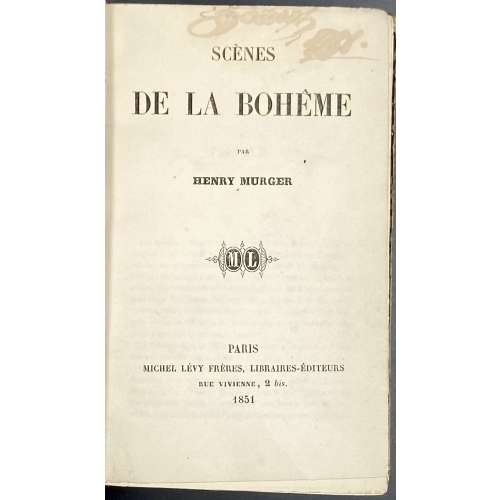 Hardcover volume, 18.2 x 11.8 cm, bound in quarter black polished calf with gilt lettering “cartonnage romantique” design to spine, marbled boards, matching marbled endpapers, blue margins. Title-page: SCÈNES | DE LA BOHÊME | PAR | HENRY MURGER | {publisher’s device ML} | PARIS | MICHEL LÉVY FRÈRES, LIBRAIRES-ÉDITEURS | RUE VIVIENNE, 2 bis. | 1851 || Half-title: ŒUVRES | D’HENRY MURGER || Advertisement: Chez le même Éditeurs. | BIBLIOTHEQUE CONTEMPORAINE | (page of text) || Collation: π2 (h.t/advert., t.p. / blank), 1-33 (17)12, χ6; total 212 leaves without ffls (3 front, 2 back). Pagination: [2] – h.t. / blank, [2] – t.p. / blank, [i] ii-xiii [xiv blank], [1] 2-406; total 424 pages. Scènes de la bohême, in later editions Scènes de la vie de bohème. Translations: Into English: LIB-2719.2021. Henri Murger. The Bohemians of the Latin Quarter. (Scènes de la vie de Bohême) / Translated from the French. — London: Vizetelly & Co., 1883. Into German: LIB-2686.2021. Henri Murger. Die Bohème : Szenen aus dem Pariser Künstlerleben. — Leipzig: Insel-Verlag, 1906. Into Russian: LIB-3182.2023. А. Мюрже. Сцены из жизни богемы / Пер. с франц. и прим. Е. А. Гунста; вст. ст. С. И. Великовского; художник Н. А. Кравченко. — М.: Художественная литература, 1963. Contributors: Murger, Henri [Henry] (French, 1822 – 1861) – author.
Hardcover volume, 18.2 x 11.8 cm, bound in quarter black polished calf with gilt lettering “cartonnage romantique” design to spine, marbled boards, matching marbled endpapers, blue margins. Title-page: SCÈNES | DE LA BOHÊME | PAR | HENRY MURGER | {publisher’s device ML} | PARIS | MICHEL LÉVY FRÈRES, LIBRAIRES-ÉDITEURS | RUE VIVIENNE, 2 bis. | 1851 || Half-title: ŒUVRES | D’HENRY MURGER || Advertisement: Chez le même Éditeurs. | BIBLIOTHEQUE CONTEMPORAINE | (page of text) || Collation: π2 (h.t/advert., t.p. / blank), 1-33 (17)12, χ6; total 212 leaves without ffls (3 front, 2 back). Pagination: [2] – h.t. / blank, [2] – t.p. / blank, [i] ii-xiii [xiv blank], [1] 2-406; total 424 pages. Scènes de la bohême, in later editions Scènes de la vie de bohème. Translations: Into English: LIB-2719.2021. Henri Murger. The Bohemians of the Latin Quarter. (Scènes de la vie de Bohême) / Translated from the French. — London: Vizetelly & Co., 1883. Into German: LIB-2686.2021. Henri Murger. Die Bohème : Szenen aus dem Pariser Künstlerleben. — Leipzig: Insel-Verlag, 1906. Into Russian: LIB-3182.2023. А. Мюрже. Сцены из жизни богемы / Пер. с франц. и прим. Е. А. Гунста; вст. ст. С. И. Великовского; художник Н. А. Кравченко. — М.: Художественная литература, 1963. Contributors: Murger, Henri [Henry] (French, 1822 – 1861) – author. -

Iron tsuba of oval form with a shakudō fukurin and rough surface decorated by low relief carving and brass inlay with a centipede emerging from under the rock on both sides.
Edo period.Size: 78.9 x 73.6 x 3.8 mm
Unsigned. However, this tsuba may be (though with reservation) attributed to Misumi Kōji school. There is some information regarding this master(s) in Tsuba. An aesthetic study by Kazutaro Torigoye and Robert E. Haynes (from the Tsuba Geijutsu-kō of Kazataro Torigoye. Edited and published by Alan L. Harvie for the Nothern California Japanese Sword Club, 1994-1997) on pages 163-4, though I was not able to locate the tsuba in the original publication. Possibly, this fragment of the book was added by Robert Haynes. Markus Sesko speculates about Misumi in his The Japanese toso-kinko Schools.// Lulu Inc., 2012 on pages 374-5: "Misumi Kōjo Tsuba. Iron plate, elliptical shape, shakudō takabori suemon, yamagane fukurin. Centipede." But of course, visual similarity does not prove anything. I was not able to find any traces of signature or a triangle on the seppa-dai.
Misumi Kōji Tsuba on p. 163.
-

Iron tsuba of mokko form with rough surface decorated in low relief carving (sukidashi-bori) and openwork (sukashi) with a flying bat, a crescent moon, and a cloud over the moon. Bat's eyes inlaid with gold. Crescent moon and cloud on the reverse. Copper sekigane. Kogai hitsu-ana plugged with shakudō.
Unsigned.
Edo period.Size: Height: 83.7 mm; Width: 80.3 mm; Thickness: 2.9 mm; Weight: 141 g.
-
 Mokkō form iron tsuba carved in relief and inlaid with soft metals (copper, gold, silver) with the design of a cormorant fisherman on the face and a boat on the reverse. Unsigned. Dimensions: 77 mm x 69 mm x 3.0 mm (at seppa-dai) Edo period: 18th or 19th century. "Since Nara period, Japanese fishermen in small boats have used cormorants (u) to catch river fish at night, binding the necks of the birds so that the fish are not swallowed. [...] The bird and the work it performs are symbols of selfless devotion to one's master and keen eyesight." - from Merrily Baird. Symbols of Japan. Thematic motifs in art and design. Rizzoli international publications, Inc., 2001; p. 104. See also in this collection TSU-0212 and TSU-0241.
Mokkō form iron tsuba carved in relief and inlaid with soft metals (copper, gold, silver) with the design of a cormorant fisherman on the face and a boat on the reverse. Unsigned. Dimensions: 77 mm x 69 mm x 3.0 mm (at seppa-dai) Edo period: 18th or 19th century. "Since Nara period, Japanese fishermen in small boats have used cormorants (u) to catch river fish at night, binding the necks of the birds so that the fish are not swallowed. [...] The bird and the work it performs are symbols of selfless devotion to one's master and keen eyesight." - from Merrily Baird. Symbols of Japan. Thematic motifs in art and design. Rizzoli international publications, Inc., 2001; p. 104. See also in this collection TSU-0212 and TSU-0241. -

Iron tsuba pierced and carved (marubori-sukashi) with the 'horse in the round' design. Possibly, Bushū-Ito school, 19th century (ca. 1800). Kogai-hitsu-ana plugged with shakudō.
Size: 67.6 x 66.8 x 5.1 mm
Unsigned.
See:
-
- Robert E. Haynes. Study Collection of Japanese Sword Fittings. Nihon Art Publishers, 2010, p. 120: Iron plate carved and formed in the round as a tethered bull...Signed: Bushū jū Sadayasu saku.
- Robert E. Haynes. Masterpiece and highly important tsuba, etc... San Francisco, 1984 // Catalog #9.: Signed: Bushū jū Yoshifusa. Ca. 1800, H 6.7 cm, Th. 4.75 mm.
- The Hartman collection of Japanese metalwork. Christie's, 1976, p. 29, №59: Bushū type, 19th century. Reference to Takezawa, Nihon Toban Zuetsu №411 for a similar design signed Bushū Yoshifusa.
4. Japanese Sword Fittings from the R. B. Caldwell Collection. Sale LN4188 "HIGO". Sotheby's, 30th March 1994, p. 17, №24: An iron tsuba, by Heianjo Sadatsune, Edo period (18th century). In the form of a horse, standing with its head lowered and a rope halter attached to its bit and trailing beneath. Signed Heianjo Sadatsune, 7.3 cm. With NBTHK Tokubetsu kicho paper, dated Showa 49 (1974). GBP 600-700.
Hartman collection, №59.

The Caldwell Collection. Heianjo Sadatsune, Edo period (18th century).
-
-
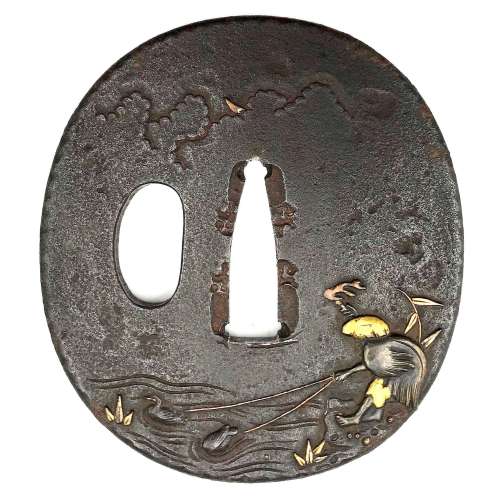 Iron tsuba of oval form carved and inlaid in gold and copper with cormorant fisherman in disguise. Unsigned. Dimensions: 67.7 mm x 61.5 mm x 3.8 mm (at seppa-dai) Edo period: 18th century. "Since Nara period, Japanese fishermen in small boats have used cormorants (u) to catch river fish at night, binding the necks of the birds so that the fish are not swallowed. [...] The bird and the work it performs are symbols of selfless devotion to one's master and keen eyesight." - from Merrily Baird. Symbols of Japan. Thematic motifs in art and design. Rizzoli international publications, Inc., 2001; p. 104. See also TSU-0212 and TSU-0096
Iron tsuba of oval form carved and inlaid in gold and copper with cormorant fisherman in disguise. Unsigned. Dimensions: 67.7 mm x 61.5 mm x 3.8 mm (at seppa-dai) Edo period: 18th century. "Since Nara period, Japanese fishermen in small boats have used cormorants (u) to catch river fish at night, binding the necks of the birds so that the fish are not swallowed. [...] The bird and the work it performs are symbols of selfless devotion to one's master and keen eyesight." - from Merrily Baird. Symbols of Japan. Thematic motifs in art and design. Rizzoli international publications, Inc., 2001; p. 104. See also TSU-0212 and TSU-0096 -

Large oval form tsuba decorated with two human figures (scholar and attendant) under the pine tree admiring a view of a waterfall on the face of the plate, and with stylized dragons carved on the reverse among the symbols of thunder inlaid in gold. The plate is carved in low relief with details inlaid with gold and silver.
Signed: Yamashiro no kuni Fushimi no ju Kaneie [Kaneie of Fushimi in Yamashiro Province] [山城國伏見住金家], with Kaō. It is a fake signature (
gimei). Size: Height: 91.9 mm; Width: 85.6 mm; Thickness: 3.4 mm; Weight: 169 g.
This is a late Edo period, 19th-century export work to cater to the tastes of the European tsuba collectors. It does not have anything in common with the work of great Kaneie masters.
SOLD -

Iron tsuba of circular form with the knotted geese (kari) flying over the rough waves pierced (sukashi) and carved in low relief (nikubori). Hitsu-ana plugged with soft metal. Hitsu-ana plugged with soft metal (tin or lead).
Signed: Echizen koku jū Myochin Katsuharu saku.
Edo period.Size: Height: 80.7 mm; Width: 81.0 mm; Thickness: 4.5 mm; Weight: 110 g.
Two tsuba of this master can be found at Georg Oeder Collection (Japanische Stichblätter und Schwertzieraten. Sammlung Georg Oeder Düsseldorf. Beschreibendes Verzeichnis von P. Vautier. Herausgegeben von Otto Kümmel.Oesterheld & Co / Verlag / Berlin, Oesterheld, 1915; LIB-1465 in this collection) under №№ 172 and 173, page 21, though no illustrations. SOLD. -

Thin six-lobed iron plate of brownish color is carved on each side with a groove that follows the rim and a concentric grooves around the center of the plate, also carved with six thin scroll lines (mokkō or handles, kan) that follow the shape of the rim. Mokume surface treatment. Hitsu-ana possibly added at a later date, and kogai-hitsu-ana plugged with gold. Silver sekigane.
Signed: Kunihide [國秀]. Higo school, 1st generation swordsmith.
Mid Edo period, ca. 1800.
Would be possibly attributed to Kamakura-bori school revival of the 19th century.
References: Nihon Tō Kōza, Volume VI / Japanese Sword / Kodōgu Part 1, page 231: Enju Kunihide, a tōshō from Higo: "...forging of the jigane is excellent, and there are also pieces with mokume hada."
Haynes Index Vol. 1, p. 741, H 03569.0: "Enju Kunihide in Higo province, died 1830, student of Suishinshi Masahide. Retainer of the Hosokawa Daimyō, etc."
Additional Information from Markus Sesko: This tsuba indeed is made by Enju Kunihide, who in his later years signed the HIDE [秀] character as HI [日] and DE [出], as here: Size: 77.4 x 74.9 x 2.7 mm
Similar pieces are:
1. In this collection № TSU-0341: Kamakura-bori tsuba with mokkō motif. Muromachi period, 15th - 16th century.
2. Dr. Walter A. Compton Collection, 1992, Christie’s auction, Part II, pp. 14-15, №16: “A kamakurabori type tsuba, Muromachi period, circa 1400. The thin, six-lobed iron plate is carved on each side with a wide groove that follows the shape of the rim, and with six scroll lines and a single thin circular groove. […] The hitsu-ana was added at a later date, circa 1500-1550. Height 8.3 cm, width 8.6 cm, thickness 2.5 mm. The tsuba was initially intended to be mounted on a tachi of the battle type in use from Nambokucho to early Muromachi period (1333-1400)”. Sold at $935.
Size: 77.4 x 74.9 x 2.7 mm
Similar pieces are:
1. In this collection № TSU-0341: Kamakura-bori tsuba with mokkō motif. Muromachi period, 15th - 16th century.
2. Dr. Walter A. Compton Collection, 1992, Christie’s auction, Part II, pp. 14-15, №16: “A kamakurabori type tsuba, Muromachi period, circa 1400. The thin, six-lobed iron plate is carved on each side with a wide groove that follows the shape of the rim, and with six scroll lines and a single thin circular groove. […] The hitsu-ana was added at a later date, circa 1500-1550. Height 8.3 cm, width 8.6 cm, thickness 2.5 mm. The tsuba was initially intended to be mounted on a tachi of the battle type in use from Nambokucho to early Muromachi period (1333-1400)”. Sold at $935.
 3. And another one in Robert E. Haynes Catalog #9 on page 24-25 under №23: “Typical later Kamakura-bori style work. This type of plate and carving show the uniform work produced by several schools in the Muromachi </em period. Some had brass inlay and others were just carved as this one is. The hitsu are later. Ca. 1550. Ht. 8.8 cm, Th. 3.25 mm”. Sold for $175.
3. And another one in Robert E. Haynes Catalog #9 on page 24-25 under №23: “Typical later Kamakura-bori style work. This type of plate and carving show the uniform work produced by several schools in the Muromachi </em period. Some had brass inlay and others were just carved as this one is. The hitsu are later. Ca. 1550. Ht. 8.8 cm, Th. 3.25 mm”. Sold for $175.

-

Very fine iron plate well hammered and turned, tapering and rolling to the rounded edge. Tsuba of a cross-form mokko shape (juji-mokko-gata) decorated with spider web inlaid in gold on both sides. The face is carved with a silver-damascened spider holding a gold-damascened butterfly (nunome-zōgan). Kozuka and kogai hitsu-ana of inome (boar's eye) form. The udenuki ana may be of purely decorative purpose.
Signed: Yatsushiro [八代] Jingo Saku [甚吾作], a signature of Chisokutei Amatsune, one of the last Jingo masters.
Late Edo period, Tenpō era, 1830-1844.Size: Height: 77.5 mm; Width: 72.8 mm; Thickness: 4.1 mm; Weight: 141 g.
In a custom wooden box.
Here is what Markus Sesko wrights in his book The Japanese toso-kinko Schools, 2012, on page 374:An artist who worked in the style of the Shimizu-Jingo school was Chisokutei Amatsune (知足亭天常). He was actually a samurai from Yatsushiro who made tsuba as a sideline. An extant old hakogaki of one of his pieces mentions that he died in Edo in the sixth month of An'ei eight (1779) at the age of 73. But the era of An'ei is probably wrong because Chikokutei (sic) is today dated by most experts around Tenpō (1830-1844). His relationships with the Shimizu school or under which Jingo master he had studied are unknown. From the point of view of production time and the finishing of nakago-ana, he is rather associated with the 5th and last gen. Shigenaga who died in the seventh year of Kaei (1854). A peculiarity of Chisokutei was that he signed his Jingo copies with "Yatsushiro Jingo Saku" ([八代甚吾作) but added the small syllable "chi" (チ) or the character "Chi" (知) for "Chisokutei" to identify them as copies.
No longer available. -
 Iron tsuba of ryō-mokko-gata form decorated with a spotted deer (Nara deer or sika deer) motif in low relief carving (sukidashi-bori) and flat silver inlay (hara-zōgan); deer's eyes and details in gold inlay. Signed on a copper cartouche: Noriyuki. Grass in low relief carving on the reverse. There were two Noriyuki in Hamano school - father (Noriyuki I, 1736-1787) and son (Noriyuki II, 1771-1852). Frankly speaking, I don't know which one made this particular piece. Edo period, late 18th or early 19th century.
Iron tsuba of ryō-mokko-gata form decorated with a spotted deer (Nara deer or sika deer) motif in low relief carving (sukidashi-bori) and flat silver inlay (hara-zōgan); deer's eyes and details in gold inlay. Signed on a copper cartouche: Noriyuki. Grass in low relief carving on the reverse. There were two Noriyuki in Hamano school - father (Noriyuki I, 1736-1787) and son (Noriyuki II, 1771-1852). Frankly speaking, I don't know which one made this particular piece. Edo period, late 18th or early 19th century.Size: 71.5 x 70.0 x 3.0 mm.
-
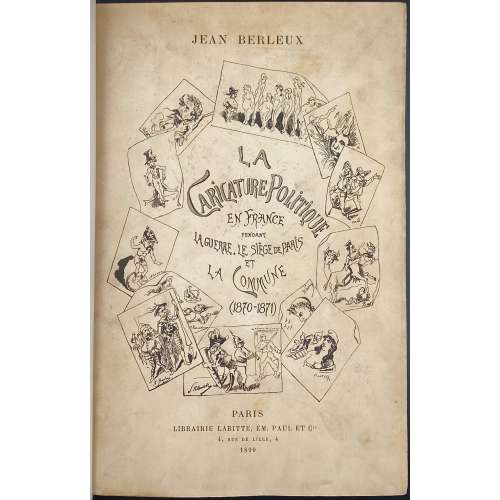 Hardcover, 25.2 x 17 cm, quarter burgundy shagreen with raised bands and gilt lettering to spine over turkish marbled boards and endpapers, publisher’s wrappers preserved. Title-page: JEAN BERLEUX | LA | CARICATURE POLITIQUE | EN FRANCE | PENDANT LA GUERRE, LE SIÈGE DE PARIS | ET LA COMMUNE | (1870–1871) | {vignette} | PARIS | LABITTE, ÉM. PAUL ET Cie | LIBRAIRES DE LA BIBLIOTHÈQUE NATIONALE | 4, RUE DE LILLE, 4 | – | 1890 || Collation: 4to; π8 1-274 282, plates within collation; total 118 leaves. Pagination: [i-ix] x-xvi, [1] 2-217 (printed 317) [3], total 236 pages, profusely illustrated, incl. in-text and full-page b/w ils, all within pagination. Condition: Good, scattering foxing, pencil marks. Contributors: Maurice Quentin-Bauchart [pseud. Jean Berleux] (French, 1857 – 1910) – author. Georges Chamerot (French, 1845 – 1922) – printer, president of the 'Chambre syndicale des imprimeurs typographes', married to Claudie Viardot (French, 1852 – 1914) in 1874 – printer. Labitte, Ém. Paul et Cie (Paris) – publisher, Adolphe Labitte (French, 1832 – 1882); Émile Paul (French, 1847 – ?). Another copy in poor condition: LIB-1653.2016, and another, a modern reprint: LIB-0814.2015.
Hardcover, 25.2 x 17 cm, quarter burgundy shagreen with raised bands and gilt lettering to spine over turkish marbled boards and endpapers, publisher’s wrappers preserved. Title-page: JEAN BERLEUX | LA | CARICATURE POLITIQUE | EN FRANCE | PENDANT LA GUERRE, LE SIÈGE DE PARIS | ET LA COMMUNE | (1870–1871) | {vignette} | PARIS | LABITTE, ÉM. PAUL ET Cie | LIBRAIRES DE LA BIBLIOTHÈQUE NATIONALE | 4, RUE DE LILLE, 4 | – | 1890 || Collation: 4to; π8 1-274 282, plates within collation; total 118 leaves. Pagination: [i-ix] x-xvi, [1] 2-217 (printed 317) [3], total 236 pages, profusely illustrated, incl. in-text and full-page b/w ils, all within pagination. Condition: Good, scattering foxing, pencil marks. Contributors: Maurice Quentin-Bauchart [pseud. Jean Berleux] (French, 1857 – 1910) – author. Georges Chamerot (French, 1845 – 1922) – printer, president of the 'Chambre syndicale des imprimeurs typographes', married to Claudie Viardot (French, 1852 – 1914) in 1874 – printer. Labitte, Ém. Paul et Cie (Paris) – publisher, Adolphe Labitte (French, 1832 – 1882); Émile Paul (French, 1847 – ?). Another copy in poor condition: LIB-1653.2016, and another, a modern reprint: LIB-0814.2015. -
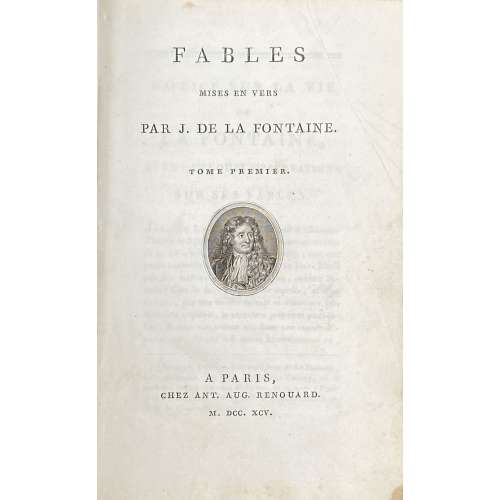 Two 8vo volumes bound in one, 19 x 12.5 cm, in full mottled sheepskin with gilt-bordered boards, gilt decorated flat spine with gilt-lettered red and black calf labels, rebacked, marbled endpapers and edges, printed on wove paper, plates on thicker laid paper. Title-page: FABLES | MISES EN VERS | PAR J. DE LA FONTAINE. | TOME PREMIER (SECOND). | {medallion portrait} (printer’s device “PC”) | A PARIS, | CHEZ ANT. AUG. RENOUARD. | M. DCC. XCV. || Collation: Vol. 1: π2 (h.t./imprint, t.p. medallion portrait/blank), [1]-38 (Notice sur la vie…), 1-58 64 (Vie de la Fontaine, Épitre, Préface, Vie d’Ésope), [7]-148 156 χ3 (table); pagination [4] [i] ii-xlviii, [1] 2-234. Total 143 leaves (286 pages) plus 6 plates after Moreau le Jeune by Devilliers fratres (p. 112), E. De Ghendt (pp. 122 and 181), Jean Louis Delignon (p. 140), Delvaux (p. 197), and Ph. Trière (p. 219). Title medallion portrait of La Fontaine (G Rigault pinx. – C S Gaucher inc.) by Gaucher after Rigaud. Vol. 2: π2 1-158 164; pagination [4] [1] 2-247 [248 blank]. Total 126 leaves (252 pages) plus 6 plates after Moreau le Jeune by Devilliers fratres (p. 19), Villerey (pp. 37, 80, and 146), Bosq (p. 121), and Ph. Trière (p. 199). The book published in 1795 (An 3) supplemented with plates produced in 1811 and 1812 for Œuvres complèttes (sic) de Jean de la Fontaine published by Lefèvre in 1814. The reason for choosing this particular edition for someone's library shortly after 1814 was probably the absence of censorship in 1795. Catalogue raisonné: (1) Lewine [LIB-2538.2020] on p. 276 (Paris, chez Renouard, 1795, 2 vols., 8vo., medal portrait on first title, and 12 plates after Moreau by Delvaux, Bosq, Ghendt, Trière, and Villerey). (2) M.-J.-F. Mahérault. L' oeuvre de Moreau le Jeune : catalogue raisonné et descriptif avec notes iconographiques et bibliographiques. — Paris: A. Labitte, 1880. Contributors: Jean de La Fontaine (French, 1621–1695) – author. Jean-Michel Moreau le Jeune (French, 1741–1814) – artist. Hyacinthe Rigaud (French, 1659 – 1743) – artist. Antoine-Augustin Renouard (French, 1765 – 1853) – publisher. Pierre Causse (French, 1761 – 1834) – printer. Engravers: Charles Étienne Gaucher (French, 1741 – 1804) Etienne De Villiers [Devilliers, Devilliers fratres] (French, 1784 – after 1844) Emmanuel Jean Nepomucène de Ghendt (Flemish, worked in France, 1738 – 1815) Jean-Louis Delignon (French, 1755 – 1820) Rémi Henri Joseph Delvaux (French, 1748 – 1823) Philippe Trière (French, 1756 – c. 1815) Auguste Villerey (French, 1801 – 1846) Jean Bosq (French, fl. c. 1801 – 1844)
Two 8vo volumes bound in one, 19 x 12.5 cm, in full mottled sheepskin with gilt-bordered boards, gilt decorated flat spine with gilt-lettered red and black calf labels, rebacked, marbled endpapers and edges, printed on wove paper, plates on thicker laid paper. Title-page: FABLES | MISES EN VERS | PAR J. DE LA FONTAINE. | TOME PREMIER (SECOND). | {medallion portrait} (printer’s device “PC”) | A PARIS, | CHEZ ANT. AUG. RENOUARD. | M. DCC. XCV. || Collation: Vol. 1: π2 (h.t./imprint, t.p. medallion portrait/blank), [1]-38 (Notice sur la vie…), 1-58 64 (Vie de la Fontaine, Épitre, Préface, Vie d’Ésope), [7]-148 156 χ3 (table); pagination [4] [i] ii-xlviii, [1] 2-234. Total 143 leaves (286 pages) plus 6 plates after Moreau le Jeune by Devilliers fratres (p. 112), E. De Ghendt (pp. 122 and 181), Jean Louis Delignon (p. 140), Delvaux (p. 197), and Ph. Trière (p. 219). Title medallion portrait of La Fontaine (G Rigault pinx. – C S Gaucher inc.) by Gaucher after Rigaud. Vol. 2: π2 1-158 164; pagination [4] [1] 2-247 [248 blank]. Total 126 leaves (252 pages) plus 6 plates after Moreau le Jeune by Devilliers fratres (p. 19), Villerey (pp. 37, 80, and 146), Bosq (p. 121), and Ph. Trière (p. 199). The book published in 1795 (An 3) supplemented with plates produced in 1811 and 1812 for Œuvres complèttes (sic) de Jean de la Fontaine published by Lefèvre in 1814. The reason for choosing this particular edition for someone's library shortly after 1814 was probably the absence of censorship in 1795. Catalogue raisonné: (1) Lewine [LIB-2538.2020] on p. 276 (Paris, chez Renouard, 1795, 2 vols., 8vo., medal portrait on first title, and 12 plates after Moreau by Delvaux, Bosq, Ghendt, Trière, and Villerey). (2) M.-J.-F. Mahérault. L' oeuvre de Moreau le Jeune : catalogue raisonné et descriptif avec notes iconographiques et bibliographiques. — Paris: A. Labitte, 1880. Contributors: Jean de La Fontaine (French, 1621–1695) – author. Jean-Michel Moreau le Jeune (French, 1741–1814) – artist. Hyacinthe Rigaud (French, 1659 – 1743) – artist. Antoine-Augustin Renouard (French, 1765 – 1853) – publisher. Pierre Causse (French, 1761 – 1834) – printer. Engravers: Charles Étienne Gaucher (French, 1741 – 1804) Etienne De Villiers [Devilliers, Devilliers fratres] (French, 1784 – after 1844) Emmanuel Jean Nepomucène de Ghendt (Flemish, worked in France, 1738 – 1815) Jean-Louis Delignon (French, 1755 – 1820) Rémi Henri Joseph Delvaux (French, 1748 – 1823) Philippe Trière (French, 1756 – c. 1815) Auguste Villerey (French, 1801 – 1846) Jean Bosq (French, fl. c. 1801 – 1844) -
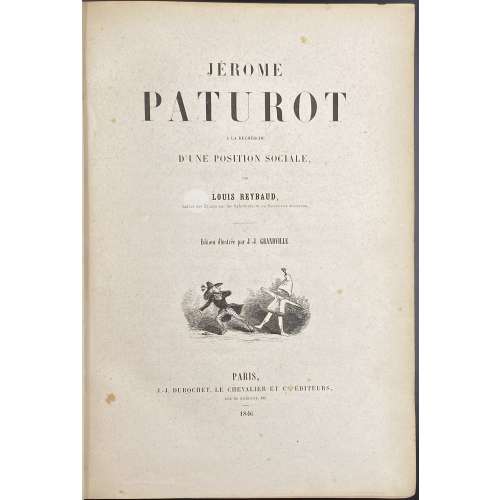 4to volume, ‘cartonnage percaline romantique’, 27.5 x 19.5 cm, green cloth with gilt fillet border and fictional coat of arms to front, border and fleuron to back, gilt and embossed vignette to spine, yellow endpapers, all edges gilt, 32 plates, incl. frontispiece, with tissue guards, and numerous in-text woodcuts after J.-J. Grandville by various engravers, mostly by Best, Leloir, Hotelin et Régnier group. Page 102 is numbered correctly. Title-page: JÉROME | PATUROT | A LA RECHERCHE | D'UNE POSITION SOCIALE | PAR | LOUIS REYBAUD, | Auteur des Études sur les Reformateurs ou Socialistes modernes. | — | Édition illustrée par J.-J. Grandville. | {vignette} | PARIS, | J.-J. DUBOCHET, LE CHEVALIER ET Cie, ÉDITEURS, | RUE DE RICHELIEU, 60. | – | 1846 || Collation: π4 1-574 582; total 234 leaves plus 32 wood-engraved plates extraneous to collation. Pagination: [8] [1] 2-460; total 468 pages, ils. Catalogue raisonné: L. Carteret 516; Ray 197 (pp. 277-8); Brivois: 350-1. Contributors: Louis Reybaud [Jérôme Paturot] (French, 1799 – 1879) – author. J.-J. Grandville [Isidore-Adolphe Gèrard] (French, 1803 – 1847) – artist. Schneider et Legrand (Paris) – printer. J.-J. Dubochet, Le Chevalier et Cie – publsiher. Engravers: Lucjan Stypulkowski (Polish, 1806 – 1849) Best, Leloir, Hotelin et Régnier Jean Baptiste Best (French, 1808 – 1879) or Adolphe Best (French, 1808 – 1860) Isidore Leloir (French, 1806 – 1851) Laurent Éloi Hotelin (French, 1821 – 1894) Eugène Laurent Isidore Régnier (?)
4to volume, ‘cartonnage percaline romantique’, 27.5 x 19.5 cm, green cloth with gilt fillet border and fictional coat of arms to front, border and fleuron to back, gilt and embossed vignette to spine, yellow endpapers, all edges gilt, 32 plates, incl. frontispiece, with tissue guards, and numerous in-text woodcuts after J.-J. Grandville by various engravers, mostly by Best, Leloir, Hotelin et Régnier group. Page 102 is numbered correctly. Title-page: JÉROME | PATUROT | A LA RECHERCHE | D'UNE POSITION SOCIALE | PAR | LOUIS REYBAUD, | Auteur des Études sur les Reformateurs ou Socialistes modernes. | — | Édition illustrée par J.-J. Grandville. | {vignette} | PARIS, | J.-J. DUBOCHET, LE CHEVALIER ET Cie, ÉDITEURS, | RUE DE RICHELIEU, 60. | – | 1846 || Collation: π4 1-574 582; total 234 leaves plus 32 wood-engraved plates extraneous to collation. Pagination: [8] [1] 2-460; total 468 pages, ils. Catalogue raisonné: L. Carteret 516; Ray 197 (pp. 277-8); Brivois: 350-1. Contributors: Louis Reybaud [Jérôme Paturot] (French, 1799 – 1879) – author. J.-J. Grandville [Isidore-Adolphe Gèrard] (French, 1803 – 1847) – artist. Schneider et Legrand (Paris) – printer. J.-J. Dubochet, Le Chevalier et Cie – publsiher. Engravers: Lucjan Stypulkowski (Polish, 1806 – 1849) Best, Leloir, Hotelin et Régnier Jean Baptiste Best (French, 1808 – 1879) or Adolphe Best (French, 1808 – 1860) Isidore Leloir (French, 1806 – 1851) Laurent Éloi Hotelin (French, 1821 – 1894) Eugène Laurent Isidore Régnier (?) -
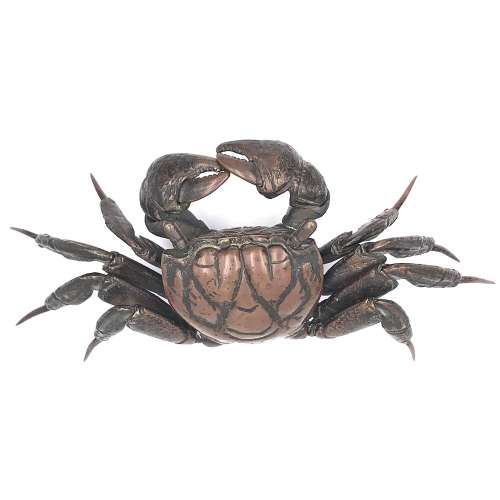 Jizai okimono bronze articulated model of a crab. Japan, Meiji period(1868-1912). Size: Body: 6.5 x 6 cm. Total: 23 x 11 cm. Weight: 762 g
Jizai okimono bronze articulated model of a crab. Japan, Meiji period(1868-1912). Size: Body: 6.5 x 6 cm. Total: 23 x 11 cm. Weight: 762 g -
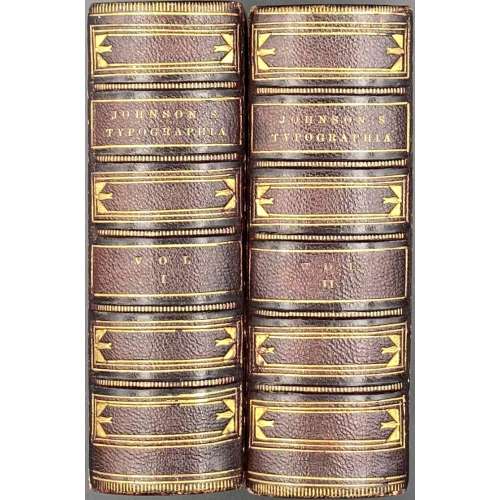 2 volume set, ¾ burgundy morocco over peacock marbled boards, ruled gilt, raised bands, gilt-ruled in compartments, gilt lettering, marbled endpapers and all margins, binding by W. S. Hiltz, NY. Vol. 1. Title: Typographia, | OR THE | Printers' Instructor: | INCLUDING AN ACCOUNT | of the | ORIGIN OF PRINTING, | with | Biographical Notices of the Printers of | England, from Caxton to the close | of the Sixteenth Century : | A Series of | Ancient and Modern Alphabets, | and | DOMESDAY CHARACTERS: | Together with | An Elucidation of every Subject con- | nected with the Art. | By J. JOHNSON, Printer. |{stanza}| Vol. I. | In frame: Published by Messrs. Longman, Hurst, | Rees, Orme, Brown & Green, Pater- | noster Row, London | Under the frame: 1824. || Pagination: Blank leaf, [2] – blank / engraved frontispiece (portrait of William Caxton by W. Hughes) w/guard, [2] – engraved t.p. by Thompson (upper margin almost none, tall lower margin, unframed) / blank, letterpress t.p. w/guard / blank, [2] – dedication to Earl Spenser and Roxburghe Club members / list of members, [2] – engraved Roxburgh Club plate by W. Hughes / blank, [4] – the pedigree of Earl Spenser, [i] ii-xii preface, [1] 2-610, [10] – index, blank leaf; printed on wove paper, text within double rule border. Vol. 2. Title: Typographia, | OR THE | Printers' Instructor: | INCLUDING AN ACCOUNT | of the | ORIGIN OF PRINTING, | with | Biographical Notices of the Printers of | England, from Caxton to the close | of the Sixteenth Century : | A Series of | Ancient and Modern Alphabets, | and | DOMESDAY CHARACTERS: | Together with | An Elucidation of every Subject con- | nected with the Art. | By J. JOHNSON, Printer. |{stanza}| Vol. II. | In frame: Published by Messrs. Longman, Hurst, | Rees, Orme, Brown & Green, Pater- | noster Row, London | Under the frame: 1824. || Pagination: Blank leaf, [2] – blank / engraved frontispiece (portrait of John Johnson ÆTATIS XLVI by William Harvey), w/o guard, [2] – engraved t.p. by G. W. Bonner (framed) / blank, letterpress t.p. w/o guard / blank, [2] – advert. / explanation of engraved title, [i]-iv contents, [1, 2] 3-663 [664], [14] – index, [2] – cantata, blank leaf; printed on wove paper, text within double rule border. Note: This is the book that served as a source of plagiarism for Adams's Typographia: a brief sketch of the origin, rise, and progress of the typographic art published in Philadelphia by himself in 1837.
2 volume set, ¾ burgundy morocco over peacock marbled boards, ruled gilt, raised bands, gilt-ruled in compartments, gilt lettering, marbled endpapers and all margins, binding by W. S. Hiltz, NY. Vol. 1. Title: Typographia, | OR THE | Printers' Instructor: | INCLUDING AN ACCOUNT | of the | ORIGIN OF PRINTING, | with | Biographical Notices of the Printers of | England, from Caxton to the close | of the Sixteenth Century : | A Series of | Ancient and Modern Alphabets, | and | DOMESDAY CHARACTERS: | Together with | An Elucidation of every Subject con- | nected with the Art. | By J. JOHNSON, Printer. |{stanza}| Vol. I. | In frame: Published by Messrs. Longman, Hurst, | Rees, Orme, Brown & Green, Pater- | noster Row, London | Under the frame: 1824. || Pagination: Blank leaf, [2] – blank / engraved frontispiece (portrait of William Caxton by W. Hughes) w/guard, [2] – engraved t.p. by Thompson (upper margin almost none, tall lower margin, unframed) / blank, letterpress t.p. w/guard / blank, [2] – dedication to Earl Spenser and Roxburghe Club members / list of members, [2] – engraved Roxburgh Club plate by W. Hughes / blank, [4] – the pedigree of Earl Spenser, [i] ii-xii preface, [1] 2-610, [10] – index, blank leaf; printed on wove paper, text within double rule border. Vol. 2. Title: Typographia, | OR THE | Printers' Instructor: | INCLUDING AN ACCOUNT | of the | ORIGIN OF PRINTING, | with | Biographical Notices of the Printers of | England, from Caxton to the close | of the Sixteenth Century : | A Series of | Ancient and Modern Alphabets, | and | DOMESDAY CHARACTERS: | Together with | An Elucidation of every Subject con- | nected with the Art. | By J. JOHNSON, Printer. |{stanza}| Vol. II. | In frame: Published by Messrs. Longman, Hurst, | Rees, Orme, Brown & Green, Pater- | noster Row, London | Under the frame: 1824. || Pagination: Blank leaf, [2] – blank / engraved frontispiece (portrait of John Johnson ÆTATIS XLVI by William Harvey), w/o guard, [2] – engraved t.p. by G. W. Bonner (framed) / blank, letterpress t.p. w/o guard / blank, [2] – advert. / explanation of engraved title, [i]-iv contents, [1, 2] 3-663 [664], [14] – index, [2] – cantata, blank leaf; printed on wove paper, text within double rule border. Note: This is the book that served as a source of plagiarism for Adams's Typographia: a brief sketch of the origin, rise, and progress of the typographic art published in Philadelphia by himself in 1837. -
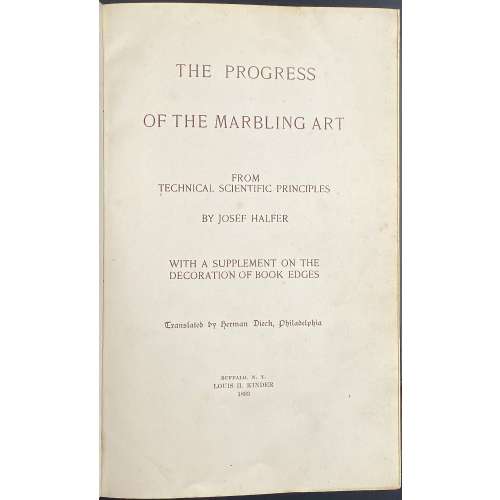 Description: One volume 22.8 x 25.4 cm, in contemporary gilt-ruled brown half morocco over green buckram boards, spine with raised bands, gilt in compartments, lettered in gilt, marbled endpapers, all edges marbled, printed in sanguine; pp. [6] [1-3] 4-234 [4], 36 blank leaves ruled red, 12 blank leaves; total 170 leaves; 35 mounted marbled paper samples on 10 sheets. Title-page: THE PROGRESS | OF THE MARBLING ART | FROM | TECHNICAL SCIENTIFIC PRINCIPLES | BY JOSEF HALFER | WITH A SUPPLEMENT ON THE | DECORATION OF BOOK EDGES | Translated by Herman Dieck, Philadelphia {gothic} | BUFFALO, N. Y. | LOUIS H. KINDER | 1893 || Edition: 1st American edition (and first edition in English) after two editions in Budapest (Austro-Hungary) in 1884 and 1890. Contributors: Josef Halfer (Austrian, 1846 – 1916) – author. Herman Dieck (American, fl. 1883 – 1896) – translator. Louis H. Kinder (American, 1867 – 1938) – publisher.
Description: One volume 22.8 x 25.4 cm, in contemporary gilt-ruled brown half morocco over green buckram boards, spine with raised bands, gilt in compartments, lettered in gilt, marbled endpapers, all edges marbled, printed in sanguine; pp. [6] [1-3] 4-234 [4], 36 blank leaves ruled red, 12 blank leaves; total 170 leaves; 35 mounted marbled paper samples on 10 sheets. Title-page: THE PROGRESS | OF THE MARBLING ART | FROM | TECHNICAL SCIENTIFIC PRINCIPLES | BY JOSEF HALFER | WITH A SUPPLEMENT ON THE | DECORATION OF BOOK EDGES | Translated by Herman Dieck, Philadelphia {gothic} | BUFFALO, N. Y. | LOUIS H. KINDER | 1893 || Edition: 1st American edition (and first edition in English) after two editions in Budapest (Austro-Hungary) in 1884 and 1890. Contributors: Josef Halfer (Austrian, 1846 – 1916) – author. Herman Dieck (American, fl. 1883 – 1896) – translator. Louis H. Kinder (American, 1867 – 1938) – publisher. -
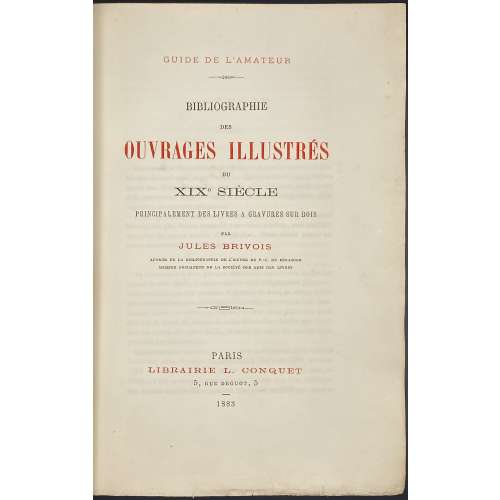 Title page: GUIDE DE L’AMATEUR | BIBLIOGRAPHIE | DES | OUVRAGES ILLUSTRES | DU | XIXe SIÈCLE | PRINCIPALEMENT DES LIVRES A GRAVURES SUR BOIS | PAR | JULES BRIVOIS | AUTEUR DE LA BIBLIOGRAPHIE DE L’ŒUVRE DE P.-J. BÉRANGER | MEMBRE FONDATEUR DE LA SOCIÉTÉ DES AMIS DES LIVRES | — | PARIS | LIBRAIRIE L. CONQUET | 5, RUE DROUOT, 5 | 1883 || Justification: Il a été tire : | 900 exemplaires sur papier vergé. | Et 50 exemplaires sur grand papier de Hollande. | Tous sont numérotés et paraphes par l’auteur. | № {188 signature} | Les numéros pairs portent le nom de M. L. Conquet. | Et les numéros impairs celui de M. P. Rouquette. | — | Le dépôt légal sera fait en France et dans tous les pays avec lesquels il | existe des conventions pour la propriété littéraire. | Tous droits réservés. || Pagination : [2] blank, [i-v] vi-xiii [xiv], [1] 2-468; the total number of pages = 484. Collation: π8 1-288 2910, an asterisk on leaf 295; the total number of leaves 242; 3 blank leaves of wove paper before and after collation. Imprint to 11 : Imp. de Mme de Lacombe; Imprint to 2910 : Nancy, imprimerie Berger-Levrault et Cie. Binding: ¾ polished distressed calf over marbled boards by the previous owner "E.D", gilt-stamped spine with gilt-lettered black label, peacock marbled endpapers, printed on laid paper. Contributors: Jules Brivois (French, 1832 – 1920) – author. L. Conquet (Paris) – publisher. P. Rouquette (Paris) – publisher. Berger-Levrault et Cie – printer.
Title page: GUIDE DE L’AMATEUR | BIBLIOGRAPHIE | DES | OUVRAGES ILLUSTRES | DU | XIXe SIÈCLE | PRINCIPALEMENT DES LIVRES A GRAVURES SUR BOIS | PAR | JULES BRIVOIS | AUTEUR DE LA BIBLIOGRAPHIE DE L’ŒUVRE DE P.-J. BÉRANGER | MEMBRE FONDATEUR DE LA SOCIÉTÉ DES AMIS DES LIVRES | — | PARIS | LIBRAIRIE L. CONQUET | 5, RUE DROUOT, 5 | 1883 || Justification: Il a été tire : | 900 exemplaires sur papier vergé. | Et 50 exemplaires sur grand papier de Hollande. | Tous sont numérotés et paraphes par l’auteur. | № {188 signature} | Les numéros pairs portent le nom de M. L. Conquet. | Et les numéros impairs celui de M. P. Rouquette. | — | Le dépôt légal sera fait en France et dans tous les pays avec lesquels il | existe des conventions pour la propriété littéraire. | Tous droits réservés. || Pagination : [2] blank, [i-v] vi-xiii [xiv], [1] 2-468; the total number of pages = 484. Collation: π8 1-288 2910, an asterisk on leaf 295; the total number of leaves 242; 3 blank leaves of wove paper before and after collation. Imprint to 11 : Imp. de Mme de Lacombe; Imprint to 2910 : Nancy, imprimerie Berger-Levrault et Cie. Binding: ¾ polished distressed calf over marbled boards by the previous owner "E.D", gilt-stamped spine with gilt-lettered black label, peacock marbled endpapers, printed on laid paper. Contributors: Jules Brivois (French, 1832 – 1920) – author. L. Conquet (Paris) – publisher. P. Rouquette (Paris) – publisher. Berger-Levrault et Cie – printer. -
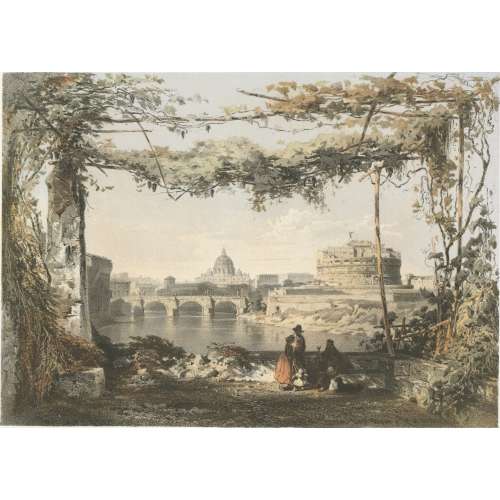
Sheet № 20 from the series of 42 сhromolithography prints 'Skizzen und Bilder aus ROM und der Umgegend' (Sketches and pictures from Rome and surroundings).
Inscriptions:
Top left: LINDEMANN-FROMMEL’S Top right: Skizzen und Bilder aus ROM und der Umgegend. Centre below: No 20 | IL CASTEL E IL PONTE SANT ANGELO, | E SAN PIETRO. Bottom left: Imp. de JACOMME et Cie. R. de Lancry, 16 Paris. Bottom centre: Stuttgart, bei FRANZ KÖHLER. Bottom right: Paris, Goupil et Cie. Editeurs.Dimensions:
Plate: 372 x 473 mm Sheet: 372 x 473 mm
Contributors:
Lindemann-Frommel, Karl (French-German, 1819 – 1891) – artist. Jacomme, Claude (French, fl. 1838 – 1857) – printer/lithographer. Goupil et Cie (Paris); Goupil, Adophe (French, 1806 – 1893) – publisher Franz Köhler (Stuttgart); Köhler, Franz (German, 1805 – 1872) – publisher.


